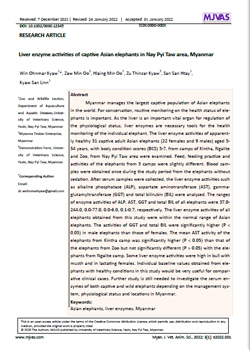
Liver enzyme activities of captive Asian elephants in Nay Pyi Taw area, Myanmar
Author: Dr. Win Ohnmar Kyaw Category: RESEARCH ARTICLE Publisher: UVS Published: July 18, 2022 ISBN: 0000-000XAbstract
Myanmar manages the largest captive population of Asian elephants in the world. For conservation, routine monitoring on the health status of ele-phants is important. As the liver is an important vital organ for regulation of the physiological status, liver enzymes are necessary tools for the health monitoring of the individual elephant. The liver enzyme activities of apparent-ly healthy 31 captive adult Asian elephants (22 females and 9 males) aged 5-54 years, with body condition scores (BCS) 5-7, from camps of Kintha, Ngalite and Zoo, from Nay Pyi Taw area were examined. Feed, feeding practice and activities of the elephants from 3 camps were slightly different. Blood sam-ples were obtained once during the study period from the elephants without sedation. After serum samples were collected, the liver enzyme activities such as alkaline phosphatase (ALP), aspartate aminotransferase (AST), gamma-glutamyltransferase (GGT) and total bilirubin (BIL) were analyzed. The ranges of enzyme activities of ALP, AST, GGT and total BIL of all elephants were 37.0-244.0, 0.0-77.0, 0.0-6.0, 0.1-0.7, respectively. The liver enzyme activities of all elephants obtained from this study were within the normal range of Asian elephants. The activities of GGT and total BIL were significantly higher (P < 0.05) in male elephants than those of females. The mean AST activity of the elephants from Kintha camp was significantly higher (P < 0.05) than that of the elephants from Zoo but not significantly different (P > 0.05) with the ele-phants from Ngalite camp. Some liver enzyme activities were high in bull with musth and in lactating females. Individual baseline values obtained from ele-phants with healthy conditions in this study would be very useful for compar-ative clinical cases. Further study is still needed to investigate the serum en-zymes of both captive and wild elephants depending on the management sys-tem, physiological status and locations in Myanmar.
Back
